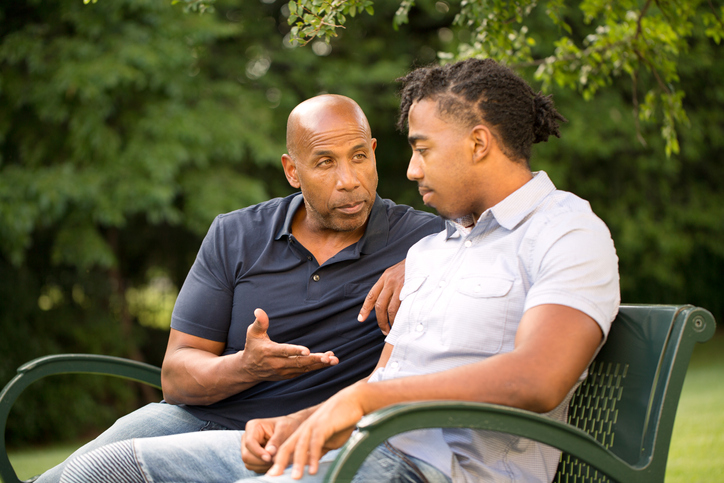Parenting Older Teens with ADHD: Land the helicopter and focus on scaffolding
 Launching older teens with ADHD can be both exciting and nerve-wracking. Your adolescent might be preparing to leave the shelter of high school for college, a gap year, trade school, an apprenticeship or a job. How do you know when to support them and when to let go? What signs indicate they are ready for the independence they desire? Teens with ADHD who often need more support for longer than is typically expected. Therefore, parenting older teens with ADHD might come with even more questions and concern. Above all, for scaffolding to be successful, your kids need to participate in its design. When parents practice compassion, collaboration and consistency with their teens, they foster much smoother transitions to adulthood.
Launching older teens with ADHD can be both exciting and nerve-wracking. Your adolescent might be preparing to leave the shelter of high school for college, a gap year, trade school, an apprenticeship or a job. How do you know when to support them and when to let go? What signs indicate they are ready for the independence they desire? Teens with ADHD who often need more support for longer than is typically expected. Therefore, parenting older teens with ADHD might come with even more questions and concern. Above all, for scaffolding to be successful, your kids need to participate in its design. When parents practice compassion, collaboration and consistency with their teens, they foster much smoother transitions to adulthood.
Helicoptering vs. Scaffolding
 There’s a big difference between being a helicopter parent and one who uses scaffolding. Helicopter parents exercise constant supervision and are over-engaged in their teen’s academic and social lives. They’re directing things to go a certain way. In addition, they’re doing things for their kids instead of letting them try more often on their own. In contrast, parental scaffolding helps teens prepare for adulthood by helping them practice independence. Instead of telling older teens and young adults how to do things and what they should choose, you discuss options. Then, when they’re 18 or older, they decide what makes sense. Rather than provide the answers to their dilemmas or problems, you offer resources and point them in the right direction. Therefore, you replace reminders with mutually created systems that foster self-reliance. You do this even if it means that your son or daughter may not succeed at something as often as you’d like. Teaching executive functioning skills, facilitating opportunities for self-reflection and exploring obstacles that prevent follow through and completion become your focus now. As the parent of two emerging adults, I know how tough it can be to witness our children struggling and succeeding–on their own terms. Although it’s much easier to say what we think and tell them why we are right, this type of communication doesn’t result in a trusting relationship. Scaffolding strategies will show more respect for their growing maturity.
There’s a big difference between being a helicopter parent and one who uses scaffolding. Helicopter parents exercise constant supervision and are over-engaged in their teen’s academic and social lives. They’re directing things to go a certain way. In addition, they’re doing things for their kids instead of letting them try more often on their own. In contrast, parental scaffolding helps teens prepare for adulthood by helping them practice independence. Instead of telling older teens and young adults how to do things and what they should choose, you discuss options. Then, when they’re 18 or older, they decide what makes sense. Rather than provide the answers to their dilemmas or problems, you offer resources and point them in the right direction. Therefore, you replace reminders with mutually created systems that foster self-reliance. You do this even if it means that your son or daughter may not succeed at something as often as you’d like. Teaching executive functioning skills, facilitating opportunities for self-reflection and exploring obstacles that prevent follow through and completion become your focus now. As the parent of two emerging adults, I know how tough it can be to witness our children struggling and succeeding–on their own terms. Although it’s much easier to say what we think and tell them why we are right, this type of communication doesn’t result in a trusting relationship. Scaffolding strategies will show more respect for their growing maturity.
Fostering Connected Independence
Connected independence is really our goal now. Ideally, our emerging adults see that we can assist them or offer advice when they seek it, demonstrate empathy regardless of the situation, and believe in their abilities to make good choices. Parents are there for you as needed, but they’re not running the show. In the meantime, to get to that place, your older adolescent will test all kinds of limits and resist taking directions from you, no matter how right you are. Teens with ADHD really need to learn from experience. For most parents, and for kids themselves, it’s a confusing time. It’s also an opportunity for you to examine your dreams for them and let them go. Take a minute and consider your agenda for your child and the type of pressure you may be placing on them. How is it working? If it’s not, do you know why? Try doing more of what works.
Tips and Tools for Parenting Older Teens with ADHD
Use these tips to foster connected independence in your family and strengthen the scaffolding of growing executive functioning skills to better help teens prepare for adulthood.
1. Listen with genuine curiosity:
 Acknowledge what you hear and use reflective listening tools to show this: “I heard you say X, did I get that right? Is there anything else?” Ask questions using how, what, when and where instead of why. Pause before thinking and reflect on what you are going to say. Are you telling them what to do? If so, how can you reframe that into a question.
Acknowledge what you hear and use reflective listening tools to show this: “I heard you say X, did I get that right? Is there anything else?” Ask questions using how, what, when and where instead of why. Pause before thinking and reflect on what you are going to say. Are you telling them what to do? If so, how can you reframe that into a question.
2. Separate your anxiety from theirs:
When we are worried about the choices our older adolescents are making, we share our anxiety–out loud or nonverbally. Monitor your concerns, keep them separate from those of your son or daughter and talk about your feelings with someone else–a friend, family member or counselor. Part of maturing into adulthood is knowing that your parents believe in your capacity for resilience. If you need to share your worries with your child, then do so neutrally.
3. Pick your battles:
 Figure out what your bottom line is about certain touchy subjects and negotiate compromises. Perhaps it is setting house limits about substance use, agreeing on minimum GPA, managing finances, or respectful language. Agree on your role for giving reminders and when you will say nothing. In general, waiting 24 hours to process something upsetting lets everybody cool down enough to have a real conversation. Effective compromises usually mean that you give a little, they give a little and nobody is fully happy with the solution. Of course, you need to intervene in matters of health and safety but discuss in advance what those might be.
Figure out what your bottom line is about certain touchy subjects and negotiate compromises. Perhaps it is setting house limits about substance use, agreeing on minimum GPA, managing finances, or respectful language. Agree on your role for giving reminders and when you will say nothing. In general, waiting 24 hours to process something upsetting lets everybody cool down enough to have a real conversation. Effective compromises usually mean that you give a little, they give a little and nobody is fully happy with the solution. Of course, you need to intervene in matters of health and safety but discuss in advance what those might be.
4. Maintain your perspective:
Negotiating the passage to adulthood takes time, practice and frustration. Take a giant step backwards to look at the entire picture. Should your child stay in college when they’re failing 3 out of 4 courses? Similarly, is keeping a miserable job with an abusive boss worth persistent high stress, insomnia, substance abuse or self-harming behaviors? Probably not. Place your attention on who they are more than what they do. Parenting older teens with ADHD often involves given them extra time and space to figure things out without excessive pressure from you. They already feel ashamed of their struggles. Remember, most kids want to grow up and be self-reliant like their peers. Talk about what they envision for themselves and help them find a counselor who really understands ADHD.
5. Facilitate learning life skills:
 The ADHD brain matures more slowly than neurotypical brains, lagging up to three years. Collaborate with your emerging adult on lagging skill areas that frustrate them. Often these involve organization, time management, planning and prioritizing. Let them take the lead on picking the ONE area that needs to be improved. Brainstorm possible solutions, explore the steps needed to work on this skill and clarify how you can help. In addition, talk with them about managing their own healthcare, prescriptions, budgets and transportation. Most young people I work with still need assistance in understanding how to do these things.
The ADHD brain matures more slowly than neurotypical brains, lagging up to three years. Collaborate with your emerging adult on lagging skill areas that frustrate them. Often these involve organization, time management, planning and prioritizing. Let them take the lead on picking the ONE area that needs to be improved. Brainstorm possible solutions, explore the steps needed to work on this skill and clarify how you can help. In addition, talk with them about managing their own healthcare, prescriptions, budgets and transportation. Most young people I work with still need assistance in understanding how to do these things.
6. Stay steady:
Emerging adulthood is a time of great change and instability. Kids come and go from your house, moving around as they try to understand the world around them and what really matters. Be there as a steady force in the midst of all of these ups and downs, loving them with open arms and a zipped mouth. They are learning as they go along: that’s what this developmental stage is all about. Expect them to reject you and your advice and give them the gift of compassion anyway. Remember what you were like at your kid’s age. What would you have wanted most from your parents? Would it have helicoptering or scaffolding strategies? I would have liked fewer questions about how I was going to use my college degree and more trust in the process of my explorations. Ultimately, I figured it out, and I bet you did too. Your teen will too.

Read more blog posts:
- Cooling Down Conversations in Neurodiverse Families: De-escalate and do-over with ‘WAIT-Now’ and ‘Take Back of the Day’
- Personal Project Planners for ADHD Minds: Start managing tasks, time and ideas with this creative tool!
- Teens, ADHD and Procrastination
Articles, interviews & more by Dr. Saline:
- Relearning Parenthood: When Children Reach Adulthood, What Then? (Psychotherapy Networker article by Dr. Saline)
- How to Get Your Teens to Open Up (WWLP 22 News Interview with Dr. Sharon Saline)
Handouts, Webinars & More in Dr. Saline’s Store:
https://drsharonsaline.com/product/anxiety/ https://drsharonsaline.com/product/home-seminar/
